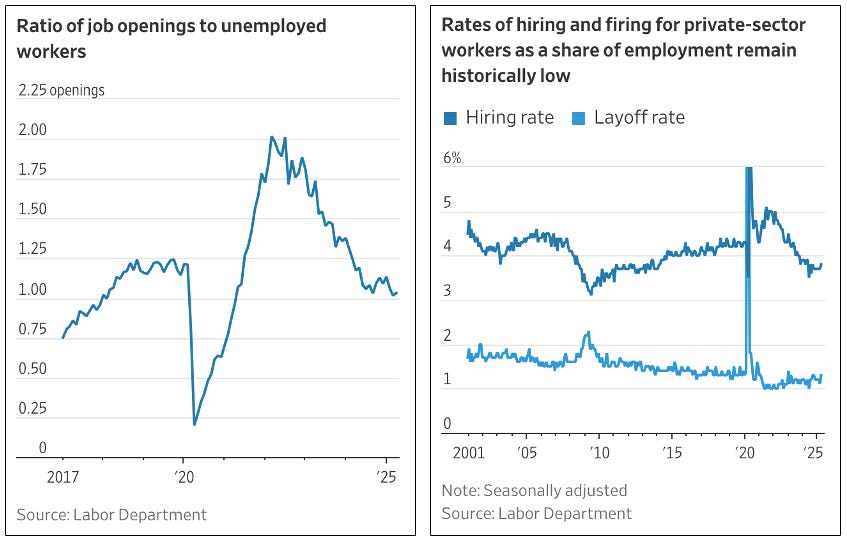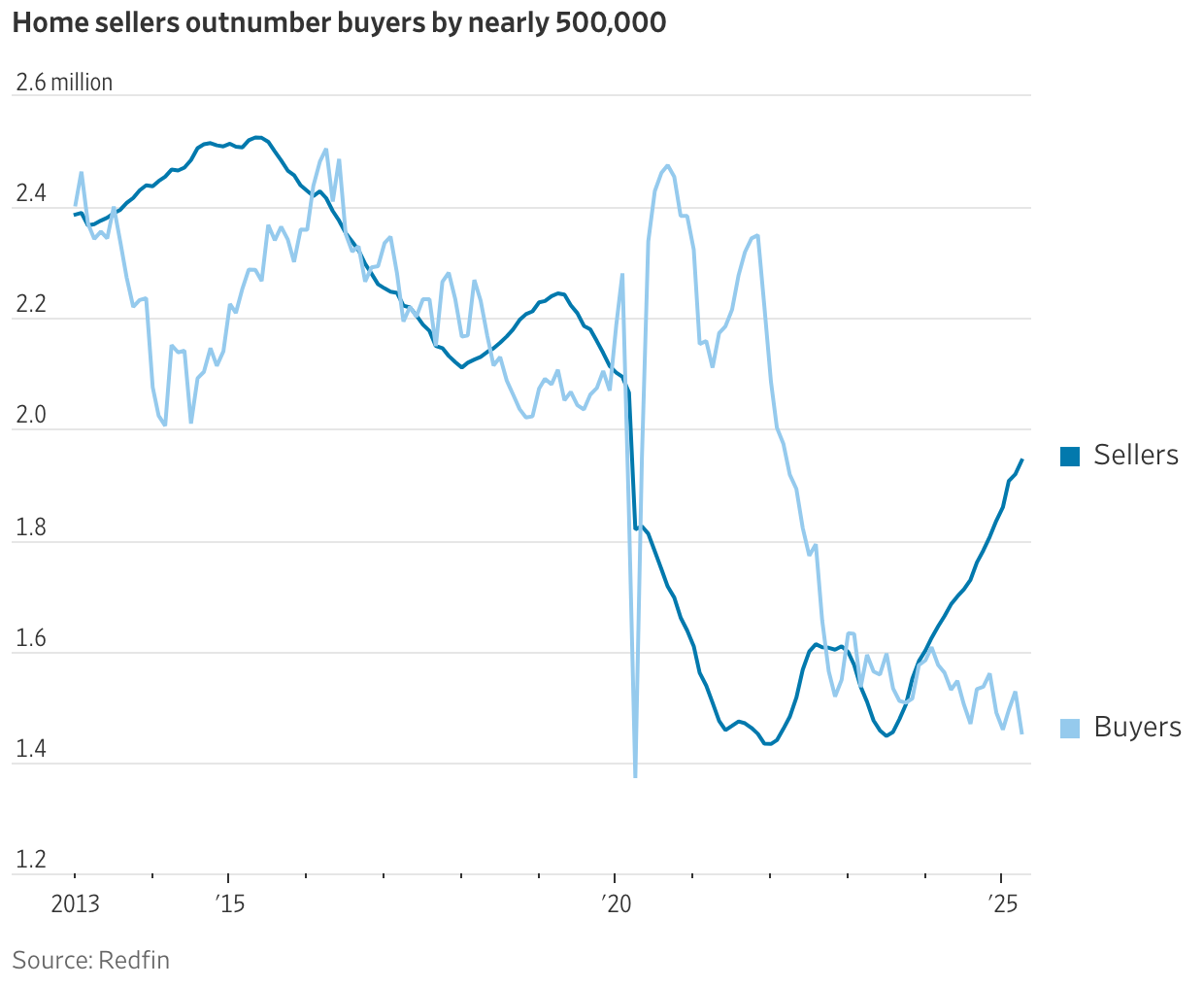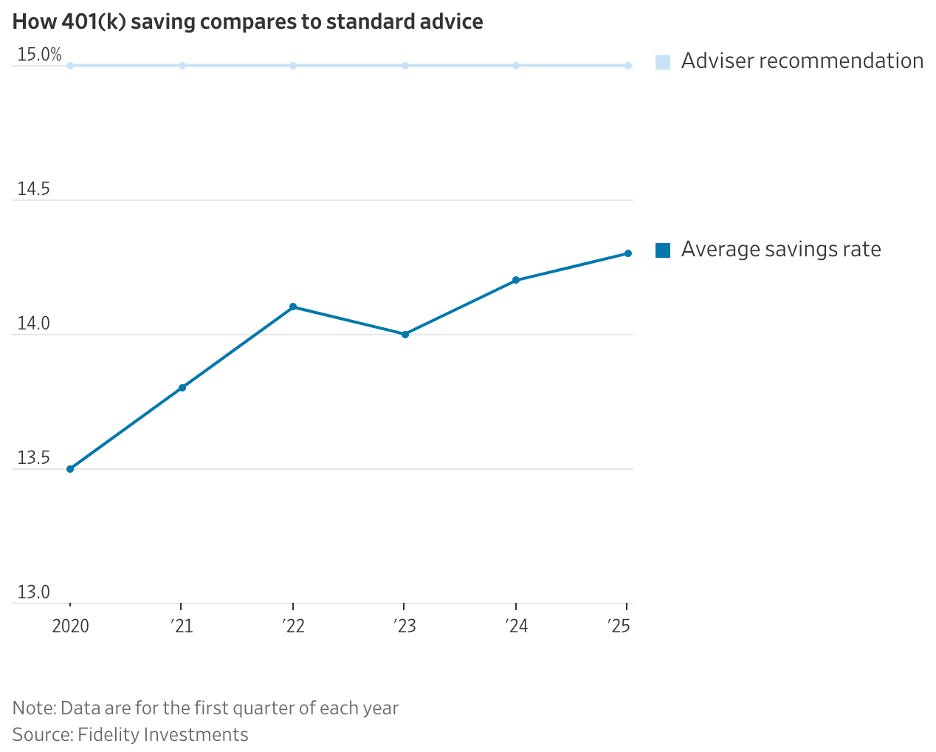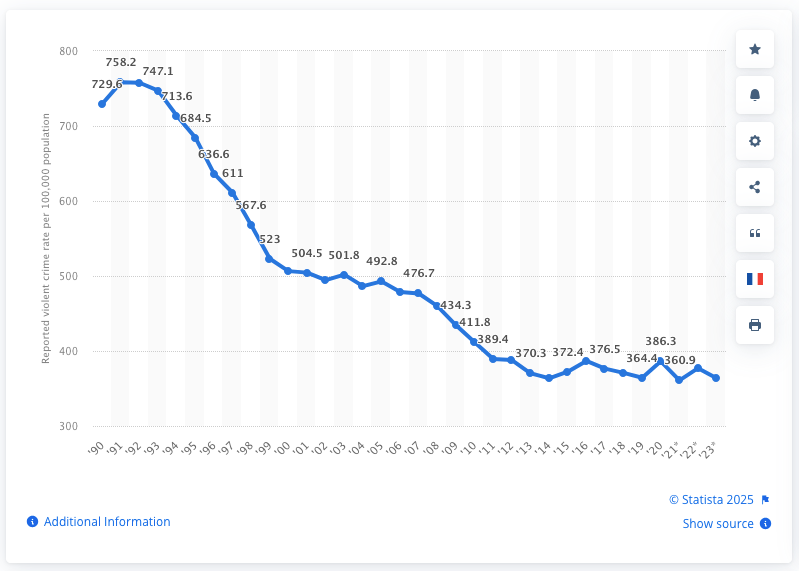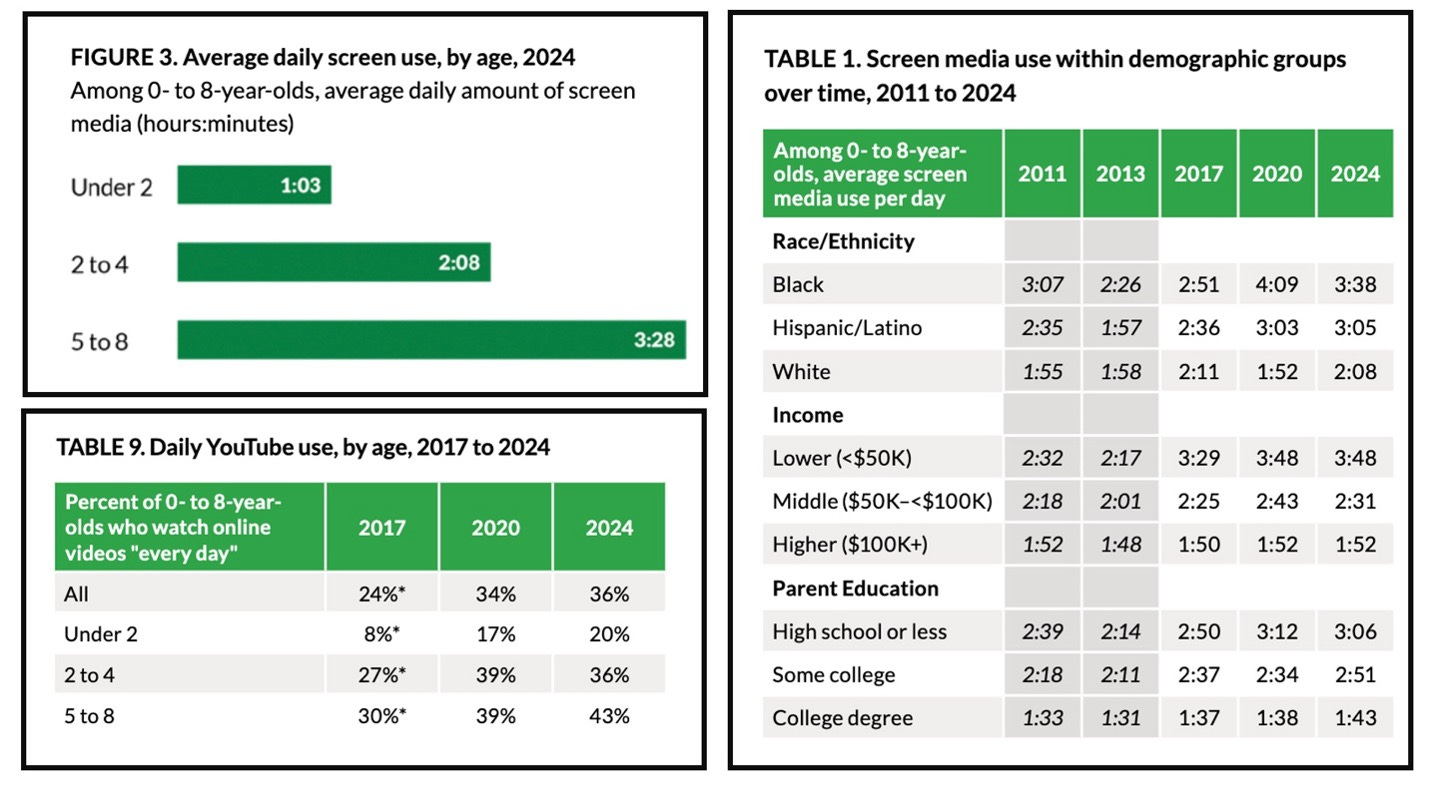9 Things from the week | 8 Jun 25
News from the past week, and a few other things.
1. The U.S. Economy Is Headed Toward an Uncomfortable Summer
The U.S. economy, which weathered false recession alarms in 2023 and 2024, is entering another uncomfortable summer. Job growth held steady in May, with the economy adding 139,000 jobs. The unemployment rate has stayed in a tight range, between 4% and 4.2%, over the past year. But there are cracks beneath the surface. Businesses are warning that constantly shifting trade policies are interfering with their ability to plan for the future, leading to hiring and investment freezes. Policy uncertainty has unfolded against the backdrop of an economy with slower job growth and a cooling housing market. Compared with last year, the Federal Reserve is more reluctant to cut interest rates because officials are worried about new inflation risks.
2. Americans Are Finally Saving Almost What They’re Supposed to for Retirement
Workers are putting away a record share of their income for retirement. The average savings rate in 401(k) plans rose to a record high 14.3% of income in the first three months of this year, according to a Fidelity Investments analysis of the millions of accounts it manages. That is just a shade below the 15% annual savings rate financial advisers often recommend over a four-decade career. Savings rates are increasing even though account balances fell in volatile markets earlier this year.
3. Worried About Decapitations? Life360 App Monetizes Parents' Worst Fears
Did you catch the new ad for the Life360 tracking app? Kidnapping! Wood-chipping! Organ-snatching! Road-tripping! The mom sings all the ways her daughter could die, each with a cartoon visual of bloody, severed organs, limbs, and heads. SO MANY severed heads. And such a perfect example of how our culture is driving parents crazy.
At this point, most of us above age 30 can still remember growing up without our parents knowing where we were every second. We waved goodbye and somehow they didn’t have a nervous breakdown. They trusted us to go places, deal with minor problems, even wait at the bus stop without them, if you can imagine. This trust also allowed them to chill.
But fear sells. So even though the crime rate today is LOWER than when most of us were kids (lower against kids AND grownups), today’s parents have grown up on a steady diet of doom. Some of this came from Law & Order. Some from local news, always chasing crime. And some came from the tsunami of “safety products” that amp up remote dangers in order to sell us the antidote.
The result is parents so force-fed fear that they can’t let their kids do almost anything on their own. A University of Michigan study found that the majority of parents of kids age nine to 11 won’t even let them play at the park with a friend, or trick or treat. Only 50% let them leave their side at the store to venture to another aisle.
Tweens are the new toddlers. As a result, parents are stuck always watching their kids. And kids are stuck always being watched. That’s not only unnecessary, it’s driving both generations nuts.
NOTE: Here’s the cringe-worthy Life 360 Video:
NOTE: The following are referenced in the full article:
Murders Plunge
The last year was often tumultuous and chaotic, but it ended with good news: Murders and crime in general declined across the country throughout 2024.
Reported violent crime rate in the United States from 1990 to 2023
NOTE: Yes, folks, despite what you might feel from the 24-hour news cycle, it is safer now in the US than it has been in decades.
4. Report: Media Use by Kids Zero to Eight
As technology continues to reshape every aspect of our society, it is more crucial than ever to understand its influence on our youngest generation. We are excited to share the latest edition of the Common Sense Census: Zero to Eight, which provides the first comprehensive look since the pandemic at how children from birth to age 8 are engaging with media and technology.
We see both challenge and opportunity in our latest findings. While 75% to 80% of parents express concerns about screen media's impact, three-quarters also recognize the potential for learning and connection. This tension—balancing technology's risks with its benefits—defines the modern parenting experience. Parents of young children face the dual challenge of navigating screen media use and preserving fundamental childhood experiences like daily reading, which has declined from 64% to 52% among 5- to 8-year-olds since 2017, even as overall screen time remains steady.
The report highlights the convergence of early childhood and technology. Screen time is no longer just a mainstay of children's entertainment and education—it's now an integral part of daily activities for many families. We found that 1 in 5 families now use mobile devices to help manage their child's bedtime routines, mealtimes, and emotional regulation.
5. OPINION | The Democrats’ Problems Are Bigger Than You Think
I have a lot of Democratic friends who are extremely disappointed with their party leaders. They tell me that the Democratic Party is currently rudderless, weak, passive, lacking a compelling message. I try to be polite, but I want to tell them: “The problem is not the party leaders. The problem is you. You don’t understand how big a shift we’re in the middle of. You think the Democrats can solve their problems with a new message and a new leader. But the Democrats’ challenge is that they have to adapt to a new historical era. That’s not something done by working politicians who are focused on fund-raising and the next election. That’s only accomplished by visionaries and people willing to shift their entire worldview. That’s up to you, my friends, not Chuck Schumer.”
There have been only a few world-shifting political movements over the past century and a half: the totalitarian movement, which led to communist revolutions in places like Russia and China and fascist coups in places like Germany; the welfare state movement, which led in the U.S. to the New Deal; the liberation movement, which led, from the ’60s on, to anti-colonialism, the civil rights movement, feminism and the L.G.B.T.Q. movement; the market liberalism movement, which led to Ronald Reagan, Margaret Thatcher and, in their own contexts, Deng Xiaoping and Mikhail Gorbachev; and finally the global populist movement, which has led to Donald Trump, Viktor Orban, Brexit and, in their own contexts, Narendra Modi, Vladimir Putin and Xi Jinping.
Many of my Democratic friends have not fully internalized the magnitude of this historical shift. They are still thinking within the confines of the Clinton-Obama-Biden-Pelosi worldview. But I have a feeling that over the next few years, the tumult of events will push Democrats onto some new trajectory.
NOTE: Though David Brooks’ opinion piece is focused on Democrats, I think there are astute observations and lessons that apply to both parties (and really society itself).
And now for some lighter fare…
6. Most Leaders Don't Even Know the Game They're In | Simon Sinek
Trust and cooperation are not standard in our organizations and yet we know they should be. There are two attributes that every single leader has the opportunity to possess that will help them create the types of organizations we would be proud to call our own. Those two attributes are empathy & perspective.
NOTE: Simon Sinek gives a great talk on leadership, society, generational differences and more. It’s really hard to believe that he gave this talk nine(!) years ago. It was a prescient warning…yet things only got worse. Lots of good nuggets here.
7. Austin Dethroned as Millionaires Flock to Arizona City
The desert city of Scottsdale, Arizona, has become the fastest-growing millionaire hub in the nation over the Texas capital, Austin, which only last year ranked first in Henley & Partners' list of U.S. metros attracting the ultra-wealthy. The former pandemic boomtown of Austin, which has been experiencing a dramatic correction over the past couple of years, has fallen out of the top five in Henley & Partners' latest report on the fastest-growing wealth hubs in the U.S., though it remains one of the richest metros in the country.
8. Human Spaceflight Mission Patches
Gallery of human space flight mission patches from Project Mercury, Project Gemini, Project Apollo, the Shuttle Program, the International Space Station Expeditions, and SpaceX Crew Missions.
NOTE: I stumbled across this site after doing some research on Apollo 8 and the famous “Earthrise” photo (learn more here). Below are some of my favorite patch designs.
With regard to Earthrise, it is normally shown like this, with the moon’s surface near-horizontal:
But, it was actually taken in orientation below, and then rotated into what you see above. To me, this original version is so much better. In space, there’s no up or down, which, to me, makes this orientation that much more disorienting and powerful.
9. Moon Replaced with Other Planets
This visualization shows how the night sky could look like to a human observer if our Moon was replaced by some of the other planets and moons in the solar system, namely Vesta, Ceres, Pluto, Triton, Europa, Io, Callisto, Mercury, Titan, Ganymede, Mars, Venus, Earth, Neptune, Uranus, Saturn and Jupiter.
NOTE: Below is just one of the fun visualizations this site provides (there are many others).
Have a great week!
The Curator


